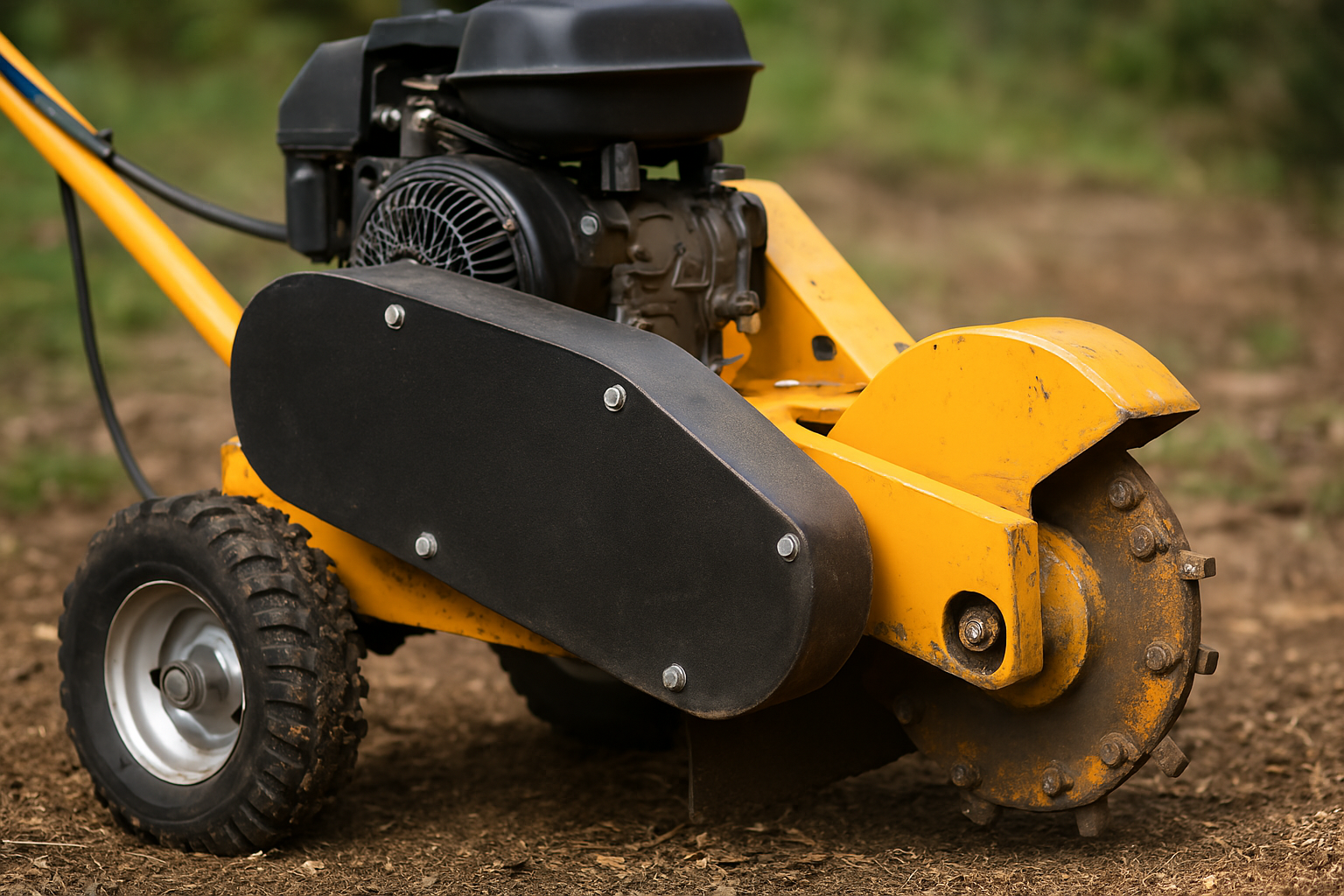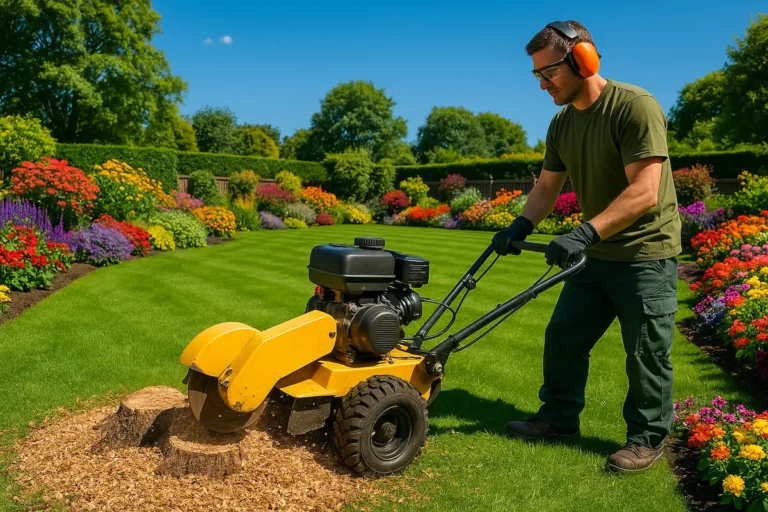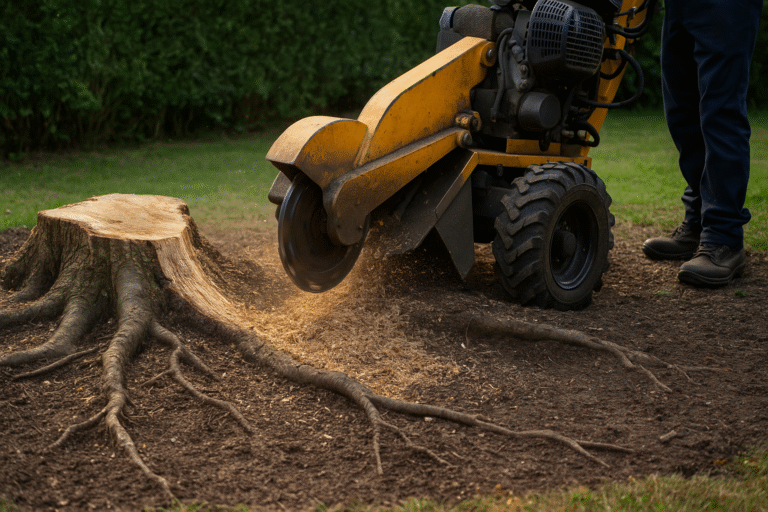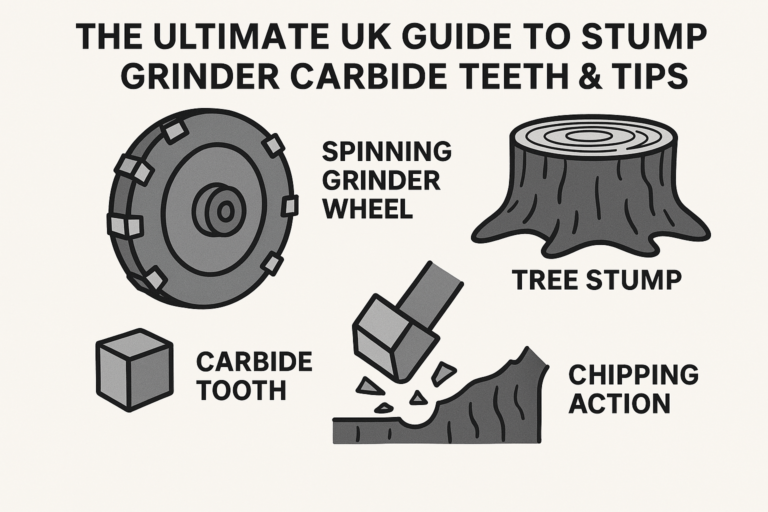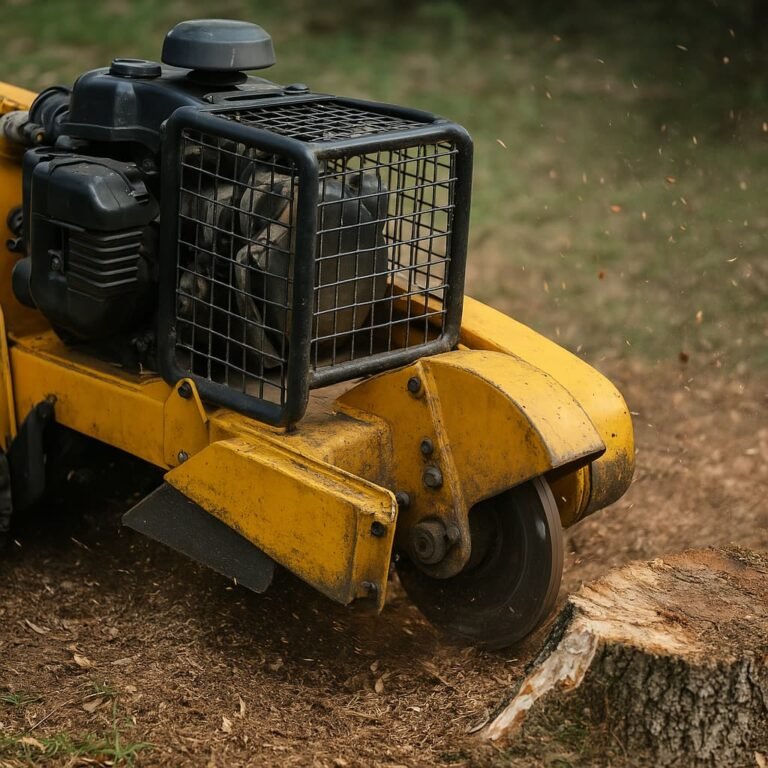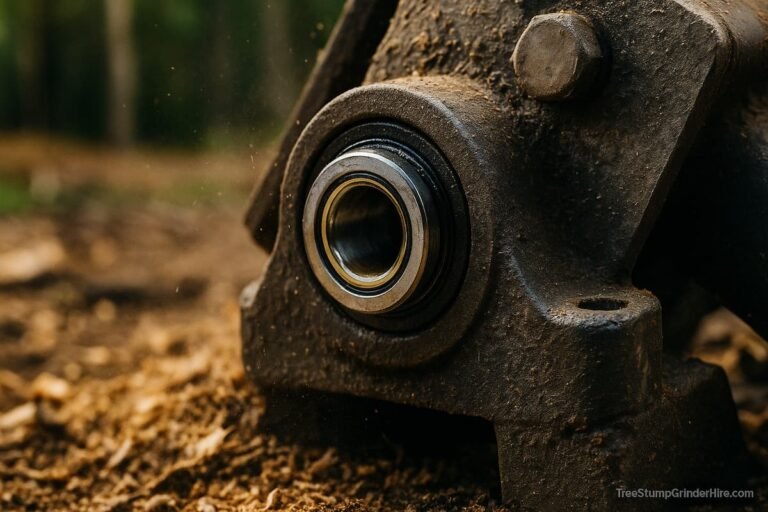All You Need To Know About the Beltcase on Your Stump Grinder
The Big Deal About the Belt Case on Your Stump Grinder
Hiring a stump grinder? You need to know about the belt case. It’s also called a belt guard. This part is super important. It keeps you safe and the machine working. Let’s learn why it matters so much.
Key Takeaways: Belt Guard Issues
- The chart highlights common problems operators face with stump grinder belt guards, ranked by potential severity.
- Safety Hazards (missing or broken guards exposing belts) represent the most critical risk, potentially leading to severe injury.
- Physical Damage (cracks, dents) is frequent due to the rough working environment and can compromise safety and lead to further failure.
- Loosening from vibration is a significant issue requiring regular checks to prevent the guard from failing or falling off.
- While less critical than immediate safety risks, Debris Buildup and Poor Maintenance Access negatively impact machine performance, belt lifespan, and increase downtime.
- Always inspect the belt guard condition before hiring or operating a stump grinder.
What is a Stump Grinder Belt Case or Belt Guard?
A belt case is a protective cover that sits over the belts and wheels (pulleys). These belts spin very fast. They carry power from the engine.
This power goes to the spinning cutter wheel, or sometimes it powers the movement parts.
Think of it like a safety shield.
It covers the fast-moving engine parts. We will mostly call it a belt guard, but a belt case means the same thing.
Why Does Your Grinder Need a Belt Guard?
This cover does some vast jobs. It’s not just a simple piece of plastic or metal. Here are its main jobs:
- Keeping You Safe: This is job number one. It stops your hands, feet, or clothes from getting caught. Belts moving fast are very dangerous.
- Protecting Machine Parts: It shields the belts and pulleys. Wood chips, dirt, and rocks can fly around, but the guard stops them from hitting the belts, preventing damage and wear. It also protects from rain and mud.
- Catching Broken Bits: Sometimes, a belt might snap. The guard helps keep broken pieces inside. This stops sharp bits from flying out. That could hurt someone badly.
Safety First: The Belt Guard’s Biggest Job
Safety is the top reason for a belt guard. Imagine those belts spinning super quickly. If your hand or clothing got caught? It could cause a terrible injury.
Fingers or hands could be lost. Loose clothing, like coat strings, can get pulled in. The guard puts a barrier there. It keeps you away from the danger zone.
In the UK, rules say machines must be safe. Having proper guards is part of that. Hire companies must give you safe machines. A good, strong belt guard is essential for this. It protects you, the person using the grinder.
This is true if you hire it for your garden. It’s also true for tree work professionals. Never use a grinder with a missing guard. Never use one with a broken guard. It’s just not worth the risk.
Keeping You Grinding: Belt Guards Help the Machine Run Well
A good belt guard helps the grinder keep working. It stops problems before they start. When the belts are covered, they stay cleaner.
Dirt and grit wear belts out fast. Wood chips can get jammed in pulleys. This can make belts slip or break. Stones kicked up by the machine can hit belts.
This can tear or shred them instantly. If a belt breaks, the grinder stops working. Your stump grinding job stops, too. This is frustrating when you have hired a machine.
You lose time and might have to pay more. For the hire company, it means repairs. They lose money when the machine isn’t working.
So, the guard protects the machine’s insides. This means less downtime for everyone. It helps the grinder do its job reliably.
What the Belt Guard Tells You About the Machine
Look closely at the belt guard. Its condition tells a story. Is it clean and fixed on tightly? This suggests the hiring company looks after things.
They likely care about safety. They maintain the whole machine well. Is the guard dented, cracked, or loose? This could be a warning sign.
Maybe the machine hasn’t been cared for. Other parts may be worn out, too. A good hire company checks these things.
They make sure guards are in good shape. Choosing a hire machine with sound guards is smart. It shows you are getting a looked-after kit.
Common Problems Operators Face with Belt Guards
Belt guards have a tough life. They get knocked about during work. Here are some common issues people report:
- Getting damaged easily.
- Shaking loose over time.
- Getting packed full of dirt.
- Being hard to remove for fixes.
Let’s look at these problems more closely.
Easy Damage: Guards Getting Hit and Broken
Stump grinding can be rough work. The machine works near the ground. Stones and bits of wood get thrown around.
These can hit the belt guard hard. If the guard is made of thin plastic? It can crack or break quite easily. Even thin metal guards can get poorly dented.
Damage also happens during loading. Or when moving the grinder on bumpy ground. People often talk about this online.
On forums like ArboristSite, users share stories. One user said their small grinder’s plastic guard broke.
It happened in the first week!
“The plastic belt guard on my grinder is a joke. I cracked it the first week. Needs to be steel.”
Another person damaged theirs, hitting a hidden rock. Some people get so fed up they make their own. They ask a metal worker to build a stronger one.
This solves the breaking problem. But a heavy steel guard adds weight. This shows factory guards aren’t constantly challenging enough.
Shaky Situation: Guards Loosening from Vibration
Stump grinders vibrate a lot. The engine runs fast, and the cutter wheel spins. This shaking travels through the whole machine. Bolts holding the belt guard can slowly loosen.
You might hear a rattling noise first. If ignored, the bolts can fall out. The guard might crack from shaking too much. In the worst case, the whole guard could fall off.
This leaves the dangerous belts exposed. Maintenance guides always say to check bolts. Tighten any loose ones before starting work.
A user on the TreeBuzz forum warned others:
“Always check the belt guard bolts before starting. Mine vibrated loose on my grinder and nearly came off.”
A mechanic fixing a grinder on YouTube showed this. The belt housing bolts were loose. This caused a lot of noise and wear. Putting special glue (thread locker) on bolts helps. It stops them from vibrating loose again.
Packed with Dirt: Debris Getting Stuck Inside
Sometimes, the guard design isn’t perfect. Or small cracks let dirt get in. Fine wood dust and soil can build up inside.
This thick layer of debris causes problems. It can make the belts get too hot. Heat makes belts wear out faster.
The debris can make belts slip on the pulleys. This means less power gets to the cutter wheel. Packed dirt can even damage the pulleys.
It’s essential to keep this area clean. Rental guides often say blow out debris. Use an air hose after each job. Some users modify guards themselves.
They try to make them shed debris better. Keeping the inside clean helps belts last longer.
Hard to Reach: Guards Making Repairs Difficult
Belts don’t last forever. They need checking and sometimes replacing. To do this, you often need to remove the belt guard. On some grinders, this is a real pain. Designers sometimes don’t think about repairs. The guard might have lots of small bolts. These bolts might be in awkward, tight spots. Mechanics complain about this online. Videos showing belt changes sometimes show struggles. Getting the cover off takes a long time. Putting it back on correctly is also slow.
One user commented about their machine:
“Getting the belt cover off a grinder to change belts takes way too long, too many small bolts in awkward places.”
This poor access costs time and money. It makes routine maintenance harder than it needs to be.
Real Stories: Learning from Other Grinder Users
Hearing from people who use these machines helps. Here are some examples of belt guard issues:
Case Study 1: Guard Kept Breaking A landscaper shared their story online. They had a small stump grinder. The factory belt guard was thin metal. Stones kept denting it.
They replaced it twice, but it kept getting damaged. Finally, they paid for a local workshop. The workshop made a heavy-duty steel guard.
This solved the problem. But the new guard made the machine heavier. This shows that standard guards can be too weak.
Case Study 2: Rental Machine Fail A tree surgeon made a video about a hire grinder. When the grinder arrived, the belt guard was cracked.
They started the job anyway. Halfway through, a piece of the guard broke off. It snagged some debris. This rubbish then got pulled into the belts.
The central drive belt got shredded. The grinder stopped working altogether. They had to stop the job.
They waited hours for a replacement machine. This caused a significant delay. It shows why checking the guard before starting is vital, even on a hired machine.
Case Study 3: The Mystery Rattle On an arborist forum, someone asked for help. Their Vermeer grinder had a nasty rattle.
They checked the engine mounts and the cutter wheel bearings. Everything seemed okay. Finally, they found the cause.
Bolts holding the main belt housing were loose. The constant vibration had shaken them. The fix was simple: tighten the bolts.
They also used thread locker fluid. This stopped the bolts from working loose again. Vibration is a common enemy of grinder parts.
These stories show common themes. Guards get damaged, vibrate loose, and cause downtime. Checking and maintaining them is key.
Before You Hire: Check The Belt Guard!
Are you planning to hire a stump grinder? Make this check part of your routine.
Before you take the machine or start work, Look carefully at the belt guard.
Here is a simple checklist:
| Check Item | What to Look For | Why It Matters |
|---|---|---|
| Is it there? | Make sure the guard is present. | Missing guard = EXTREME DANGER! |
| Is it complete? | No large holes or missing sections. | Holes defeat the purpose of guarding. |
| Any visible damage? | Look for cracks, big dents, breaks. | Damage weakens it, could fail later. |
| Is it securely fastened? | Gently push/pull it. Check bolts. | Loose guard could fall off/rattle. |
| Does it cover properly? | Ensures belts/pulleys are shielded. | Stops accidental contact/debris. |
If the guard looks damaged or missing? Do not accept the machine. Tell the hiring company immediately. A Reddit user shared this experience: “Had a rental grinder show up with no belt guard. Sent it straight back. Not worth the risk.” Your safety is more important than starting quickly.
Looking After the Guard: Simple Steps
Even on a short hire, take care of the guard. A few simple habits help:
- Look Before Use: Always glance at the guard before starting. Check for apparent damage or looseness.
- Report Damage: If you notice damage during use, stop. Tell the hiring company straight away.
- Keep it Clear: After grinding, clear away wood chips. Brush or blow debris off the guard area; don’t let dirt build up around it.
These simple checks take seconds. They help keep you safe and also help the next person who hires you.
Plastic vs Metal Guards: What’s the Difference?
Stump grinder belt guards are usually plastic or metal. Each has good and bad points.
- Plastic Guards:
- Often found on smaller grinders.
- Lighter weight.
- It can be cheaper to replace if broken.
- BUT much less intense.
- It is more straightforward to crack or break from impacts.
- Metal Guards (Steel or Aluminium):
- Usually found on bigger, professional machines.
- Much more substantial and more brutal.
- Offers better protection from impacts.
- Lasts longer in rough conditions.
- But they are heavier.
- It can be more expensive to replace if damaged.
For tough jobs or frequent use? Metal guards are generally better. They stand up to the work environment. Some users like the stronger guards on newer machines: “Appreciate the robust steel guards on the newer Bandit grinders. They hold up much better than the old ones.”
The Price of Problems: Costs of Guard Issues
What happens if the belt guard fails or is missing? The costs can be high in different ways.
- Repair Costs:
- Replacing a small plastic guard might cost £40 – £130.
- Larger metal guards can cost £180 – £550 or more.
- Complex guards on big machines cost even more.
- If you need a custom-made guard, that’s an extra cost.
- Downtime Costs:
- If the grinder stops, your job stops.
- This means lost working time.
- For professionals, this is lost income.
- For DIY hires, it’s wasted hire time.
- Waiting for repairs or parts takes time.
- Safety Costs:
- This is the most significant cost to think about.
- An accident involving moving belts can change your life.
- Severe cuts, broken bones, or losing fingers are possible.
- No amount of money makes up for a serious injury.
- Safety rules exist for a reason. Guards prevent accidents.
Looking after the guard saves money and pain later. The cost of a replacement guard is tiny. Compared to the cost of downtime or an injury? It’s nothing.
Our Promise: Safe Machines at treestumpgrinderhire.com
We take safety very seriously. Your well-being is our top priority. That’s why we check every stump grinder hire company carefully. Our checks always include the belt guard. We make sure it is:
- Present and correctly fitted.
- Free from significant damage.
- Securely bolted in place.
- Functioning as it should. If a guard is damaged, we repair or replace it. We only use machines with effective guards. This is part of our commitment to providing a safe kit. You can hire from us knowing safety checks are done.
Conclusion: Check That Belt Guard – It Matters!
The belt guard might seem like a small part. But it plays a huge role. It protects you from serious harm. It protects the machine’s essential parts. It helps ensure your hiring goes smoothly. It shows if a machine is well looked after.
So, remember these simple steps:
- Always check the belt guard before hiring or starting work.
- Make sure it’s present, undamaged, and secure.
- Never use a grinder with a faulty or missing guard.
- Report any damage to the hire company immediately.
Paying attention to the humble belt guard? It helps you have a safe and successful stump grinding job.

